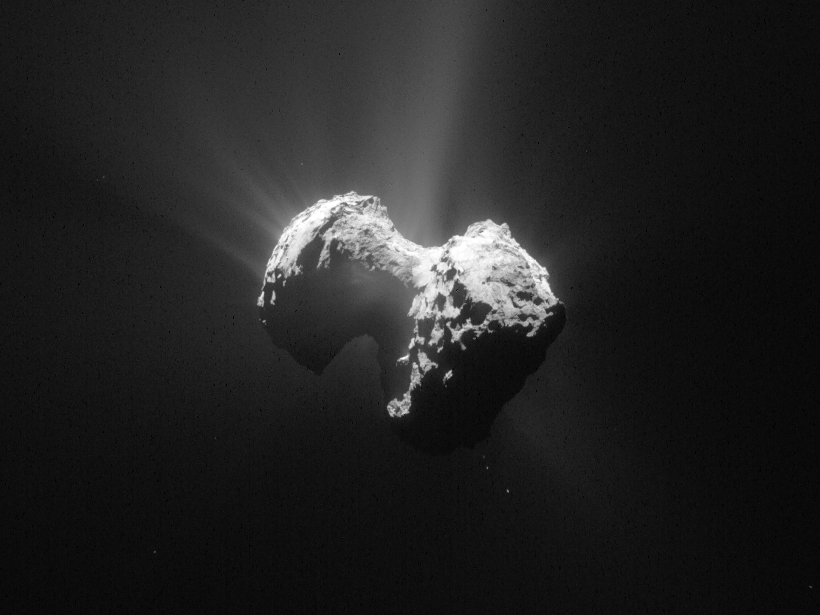Philae’s failed harpoons may have been a blessing in disguise.
Last November, the harpoons’ failure to anchor the lander where it initially touched down on comet 67P/Churyumov-Gerasimenko caused the probe to bounce across the comet’s landscape. Now mission scientists report that Philae has found a scientific surprise at its final resting place: The ground there harbors a much harder surface than scientists thought could exist on a comet.
In addition to the remarkably hard terrain, Philae has observed several novel features of its new home, including organic chemicals never found on a comet before—all described in a set of six scientific papers published yesterday in the journal Science. The suite of discoveries may provide new insights into how comets form.
Philae initially touched down on an area of the comet called Agilkia, which has a granular surface composed of silicate grains and organics covering harder bedrock, as expected by mission scientists. But when the harpoons didn’t secure the lander, it bounced twice and ultimately landed in Abydos, about 1.3 kilometers away. There, Philae encountered a surface with a hardness similar to pumice.
He compared the hardness of the newly analyzed surface to the compacted snow of a glacier.
“There is very hard material, with a little dust on the surface,” said Jens Biele, payload manager for Philae at the German Aerospace Center and lead author of one of the Science papers. He compared the hardness of the newly analyzed surface to the compacted snow of a glacier, called firn snow.
A sturdy surface could suggest “a hard crust of the same grains that we’ve seen before but now glued together with probably water ice or other ice,” he continued.
Images captured by Philae—which have been stitched together as this animation—show the comet’s surface as the lander dropped onto it on 12 November 2014. Credit: ESA/Rosetta/ROLIS/DLR
Comets in the Laboratory
In the early 1990s, German scientists created a comet analog in the laboratory by spraying water and dust into liquid nitrogen and exposing the mixture to a vacuum while simulating the Sun’s radiation. They found that some of the water would freeze, cementing the dust particles together over a few hours. This led them to surmise that comets could have hard, icy surfaces.
However, a few years later, NASA’s Deep Impact mission smashed a probe into a real comet—called Tempel 1—and found it to be weak and powdery. Other space probes similarly found a lack of hard material, namely, ice, on the surfaces of other comets.
Considering Philae’s new findings, Biele believes it’s time for scientists to revisit the 1990s experiments and further explore the evolution of comets.
“Large portions of the comet seem to consist of this consolidated material that forms the spectacular cliffs and rugged landscape you see in many parts of the comet,” Biele said. For now, research by a handful of European scientists on how this material coalesces and becomes hardened is just getting started, he continued.
Organics
In another of the Philae-focused Science papers published on 30 July, scientists report on the variety of complex organic compounds measured by the spacecraft’s onboard instruments, including four compounds—methyl isocyanate, acetone, propionaldehyde, and acetamide—not previously observed on a comet. A few of these compounds, including one of the newly observed ones, are considered important to the synthesis of biologically necessary molecules such as amino acids and complex sugars.
The compounds “would come in handy for the building of more complicated molecules,” said Fred Goesmann, lead author on the paper and principal investigator for Philae’s Cometary Sampling and Composition experiment. “If that is a path towards life, I don’t know. But it does not look like a path in the opposite direction.”
“The early solar system provided an environment where life would feel welcome.”
“This way the early solar system provided an environment where life would feel welcome,” Goesmann continued.
Relatively small and rocky, comets formed in the early days of our solar system and originated in the Oort Cloud, a vast shell of icy bodies that inhabit the solar system’s outskirts. Because organic molecules are not uncommon on comets, some scientists believe that comets could hold the secret to life on Earth.
Philae’s Status
The observations analyzed in the new studies were made by Philae before 15 November 2014. That was when the probe’s batteries ran out after the lander’s bouncy debut on the comet deposited it where it couldn’t initially receive enough sunlight to recharge the cells. After Philae finally received adequate Sun exposure, it radioed mission control once in late June and again on 9 July but has been silent ever since.
The lander still has enough power to last until October or November, said Philae project manager Stephan Ulamec, but there might be a problem with a transmitter unit.
Although the prospects for future scientific findings from Philae remain uncertain, project scientists seem optimistic. “As soon as we get better radio contact, we are prepared to do more science,” Ulamec said.
—JoAnna Wendel, Staff Writer
Citation: Wendel, J. (2015) Comet lander makes a hard discovery, Eos, 96, doi:10.1029/2015EO033623. Published on 31 July 2015.
Text © 2015. The authors. CC BY-NC 3.0
Except where otherwise noted, images are subject to copyright. Any reuse without express permission from the copyright owner is prohibited.

